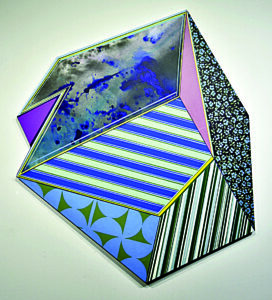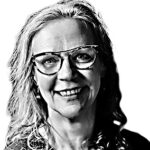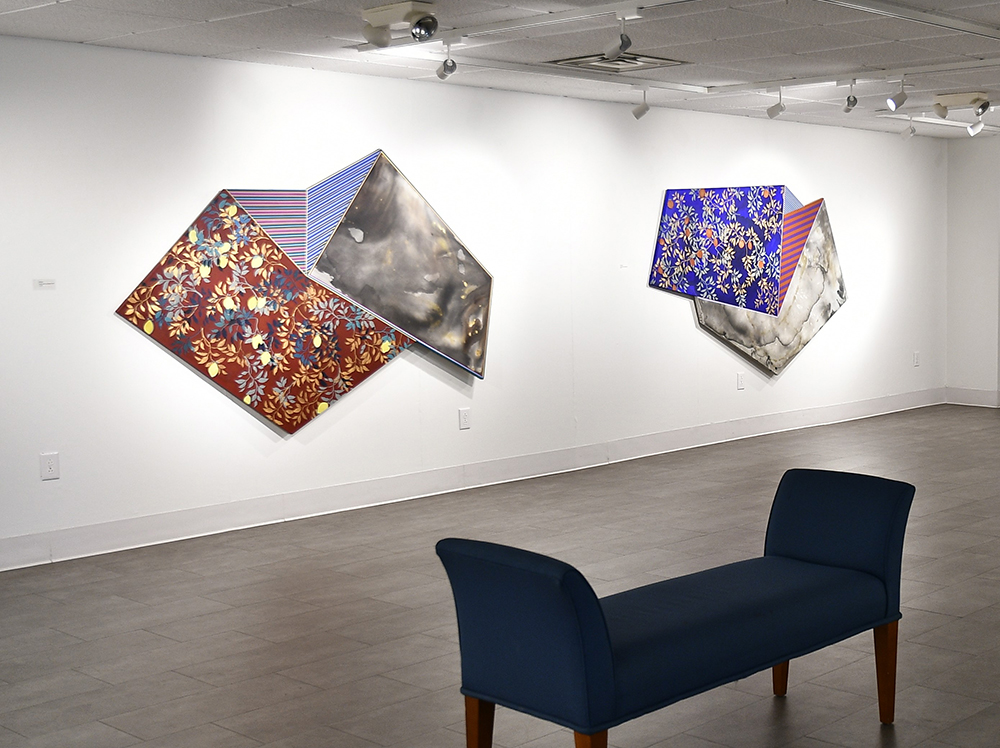Nichole Gronvold-Roller begins with stain. Using acrylic inks she follows the density and dissolving transparency of singular color on the surface of canvas. Organic forms emerge that often become mostly hidden. These areas are an atmospheric counterpoint to finely honed geometries, reflecting the every-day-ness of corners, doorways, delineations and trajectories.
My fellow Community Word contributor has been working with the properties of surrounding space for several years. It is her way of interpreting the landscape around her in rural Tremont: The gridded organization of farmed fields and household plot lines, the geometry of human organization, of perspective of our way of negotiating the land around us. Gronvold-Roller pits that geometry against the interior world of household domesticity. It’s decor and lived-in architecture.

Nichole Gronvold-Roller created the 40×45-inch ‘La Mer’ with acrylic and ink on shaped canvas. The longtime art educator from Tremont intreprets her surroundings both inside and out.
LISA NELSON RAABE
Early paintings formed variations on the edge of rectangular canvases. MDF board and more stable surfaces whirl in asymmetric concentricity. Shaped surfaces, placed in relation to each other form another phase of her work, resolving her current investigations into asymmetric outer edges that form internal planes pulling toward and away from the viewer.
Gronvold-Roller’s current work takes these geometries to the edge of the canvas. Her husband Nick’s expert craftsmanship in the display facilitates acute and obtuse angles with masterful precision. One familiar with Geometric Abstraction will easily connect to Frank Stella’s shaped paintings, which upon inspection reveal torn canvas edges fraying from the pull of angular stress. Ellsworth Kelly’s solidly colored shaped works are more expertly resolved but not with the edges Gronvold-Roller is exploiting. She begins with form that could be resolved in many ways, finding a pathway through as planes recede and approach, overlapping, yet not aligning. It is an amazing feat and a deep bow of gratitude to Nick that her canvases present clear edges that reflect and support the interior precision of her work.
Gronvold-Roller uses line and simple colored edges like we find on the decorated sheets or pillows in our home. She uses other patterns derived from home decor — cultural idioms taken from the Pennsylvania Dutch, ornamented wallpaper, vegetation-inspired, rhythmic and repeating — as stencils to transfer directly onto her surfaces. She contrasts the cold, hard-edged harshness of minimalism and geometric abstraction with these softer, domestic images. The spaciousness of her initial stained areas form a resting place of atmospheric contemplation.
Stretched canvases that reach toward six feet lengthwise were shown last October at the Peoria Art Guild. Complimented by smaller concentric paintings, he works formed angular constructions and a collection of drawn designs painted with gouache on paper.
If you missed seeing her work, you will most likely find her showing in Milwaukee at James May Gallery or Cedar Rapids, Iowa, at the Gilded Pear. Her work has been shown at the Des Moines Art Museum and currently is presented as part of “Beyond Painting” at the Spartanburg Art Museum in South Carolina.
For those who may consider our part of the American landscape flyover country, Nichole Gronvold-Roller, who has been teaching art at Tremont High School for 25 years and received her MFA from Bradley University in 2023, exemplifies “Peoria’s Hidden Treasures,” so adeptly coined by Channy Lyons. Nichole is a treasure and source of joy and intrigue, and she invites us to see America’s heartland from a new perspective.


